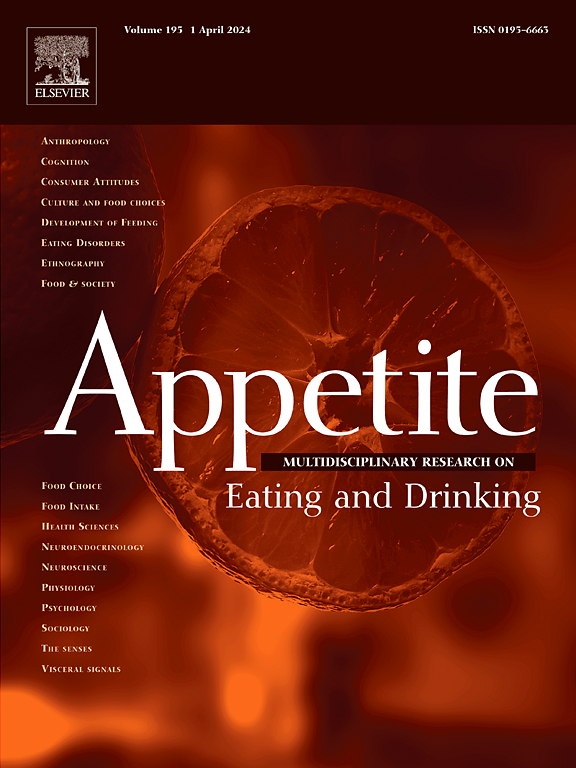唯一不变的是变化:食物接触偏差的稳定与可变方面与食物渴望和摄入量的关系不同。
IF 3.8
2区 医学
Q1 BEHAVIORAL SCIENCES
引用次数: 0
摘要
接近食物比避免食物更快的倾向(即接近偏差)被认为会促进食物摄入,尤其是与个人饮食目标相冲突的食物。然而,这种关系一直难以证明,这也是目前关于这种认知行为偏差是代表稳定特质还是波动状态的争论焦点。因此,我们研究了食物接近偏差的时间波动(1)、偏差与食物渴望(2)和摄入量(3)之间的内部联系,以及自上而下的控制在偏差与摄入量之间的联系中的作用(4)。76 名参与者填写了一份冲动性问卷,并在 9 天内完成了一项基于智能手机的接近-回避任务。在研究期间,他们还每天报告自己对 12 种个性化食物的渴望、摄入量和饮食意向,他们希望在研究期间少吃或多吃这些食物。接近偏差在个体内部存在很大差异(1),并以意想不到的方式与食物渴望(2)和摄入量(3)相关联;接近偏差与摄入量的这种关联被饮食意向和冲动性的个体间差异(而非每日波动)所调节(4)。研究结果表明,有必要重新认识接近偏差,将其视为由状态和特质两部分组成,并表明自上而下控制中更类似于特质的方面控制着接近偏差与摄入量之间的关系。接近偏差每天都有很大的变化,这也许可以解释为什么单次偏差测量往往不能预测体重等远期结果。此外,我们的研究结果表明,针对接近偏差的干预措施可能对某些时间点(高风险情况)和个体(饮食意愿不强的个体)最为有效。本文章由计算机程序翻译,如有差异,请以英文原文为准。
The only constant is change: Stable vs. variable aspects of food approach bias relate differently to food craving and intake
The tendency to approach food faster than to avoid it (i.e., approach bias) is thought to facilitate food intake, particularly foods that conflict with one's dietary goals. However, this relationship has been difficult to demonstrate, which ties into an ongoing debate about whether such cognitive-behavioral biases represent stable traits or fluctuating states. We thus investigated the temporal fluctuations of food approach bias (1), its within-participant association with food craving (2) and intake (3), and the role of top-down control in this bias-intake association (4). The 76 participants completed an impulsivity questionnaire and performed a smartphone-based approach-avoidance task on nine days. Every day, they also reported their daily craving, intake, and dietary intentions for 12 personalized foods they wanted to eat less or more often over the study period. Approach bias varied considerably within individuals (1), and correlated in unexpected ways with food craving (2) and intake (3); this association of approach bias with intake was moderated by inter-individual differences (rather than day-to-day fluctuations) in dietary intentions and impulsivity (4). Results emphasize the need to re-conceptualize approach bias as comprising both state and trait components, and indicate that the more trait-like aspects of top-down control gate the relationship of approach bias with intake. The large day-to-day variation in approach bias may explain why single-session bias measures often do not predict distal outcomes like body weight. Furthermore, our results suggest that interventions targeting approach bias may be most effective for certain timepoints (high-risk situations) and individuals (those with weak dietary intentions).
求助全文
通过发布文献求助,成功后即可免费获取论文全文。
去求助
来源期刊

Appetite
医学-行为科学
CiteScore
9.10
自引率
11.10%
发文量
566
审稿时长
13.4 weeks
期刊介绍:
Appetite is an international research journal specializing in cultural, social, psychological, sensory and physiological influences on the selection and intake of foods and drinks. It covers normal and disordered eating and drinking and welcomes studies of both human and non-human animal behaviour toward food. Appetite publishes research reports, reviews and commentaries. Thematic special issues appear regularly. From time to time the journal carries abstracts from professional meetings. Submissions to Appetite are expected to be based primarily on observations directly related to the selection and intake of foods and drinks; papers that are primarily focused on topics such as nutrition or obesity will not be considered unless they specifically make a novel scientific contribution to the understanding of appetite in line with the journal's aims and scope.
 求助内容:
求助内容: 应助结果提醒方式:
应助结果提醒方式:


